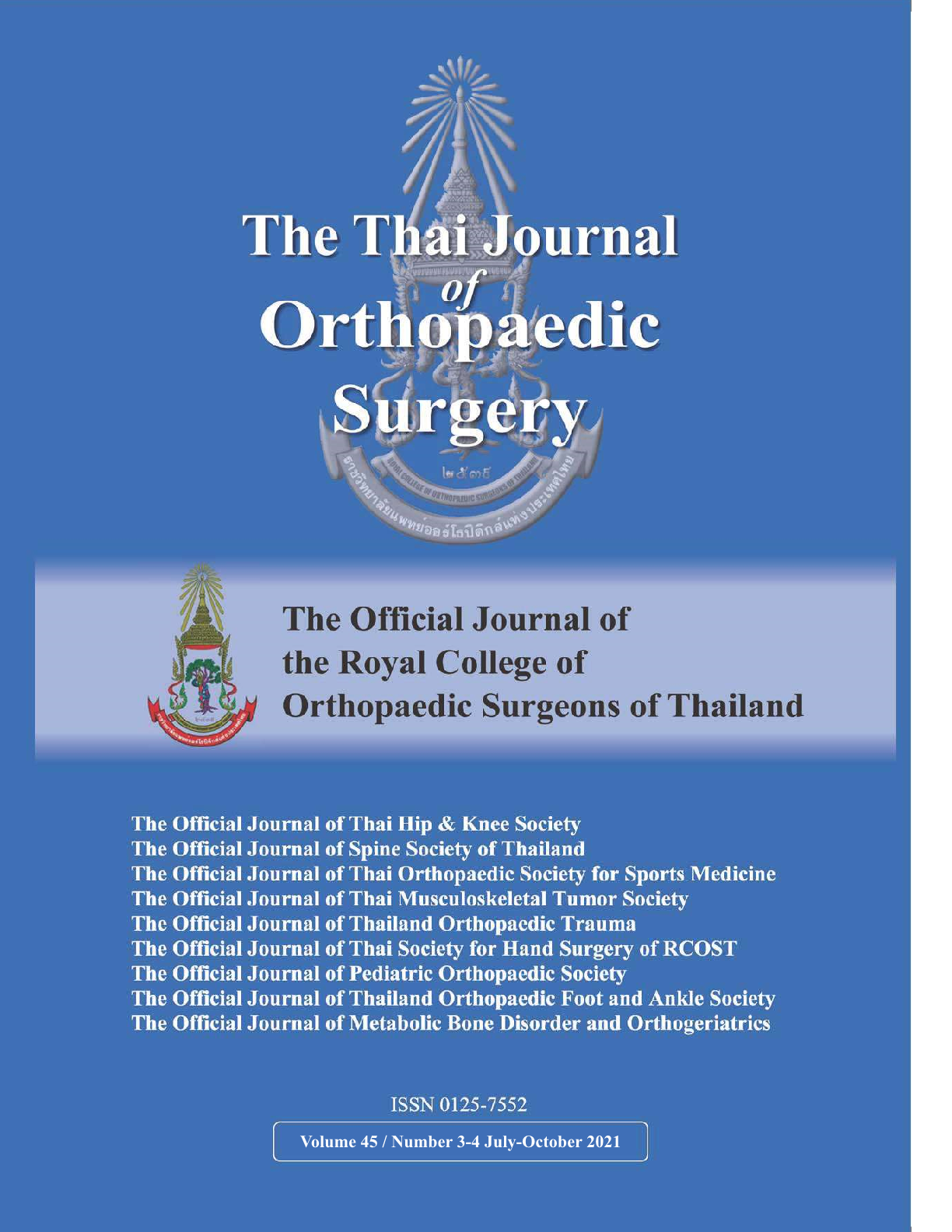Results of Cement with Screw Augmentation for Large Tibial Defects in Primary TKA
Main Article Content
Abstract
Objectives: To compare the outcome of TKAs using screw augmentation and cement in cases involving a large tibial defect with conventional TKA procedures in cases with no tibial defect using clinical and radiographic data.
Materials and Methods: A retrospectively reviewed of 217 TKAs that operated at Nakhon Pathom Hospital from January 2010 - March 2021.TKAs have divided into 54 knees with a large tibial defect treated using screws with cement augmentation (the screws group), and 163 knees with a small or no tibial defect treated with conventional TKA procedures (the no screws group). Patient information collected included age, gender, limb alignment, length of follow-up period, defect depth, presence of radiolucency lines, Knee Society scores and incidence of prosthesis loosening.
Results: There was no statistically significant differences between the groups in mean ages (64 yrs.), follow-up period (6 yrs.), BMI, gender (female 88%) and post-operative overall alignment (4.35o). While pre-operative varus angle of screw group (-15.96o), incidence of radiolucency lines of screw group (59%) and improvement of Knee Society Scores after surgery were significantly differences (P-value < 0.001). The average defect depth was 11.99 mm and most of the depths was in range of 10-20 mm. There were 6 cases of loosening prosthesis in the no screws group and 3 cases in the screws group. The survival rate of implants was 96% in the no screws group and 94% in the screws group with no difference in statistic.
Conclusions: At mean follow-up of 6 years, the cement with screw augmentation for large tibial defects had a survival rate equal to conventional TKA in cases without bone defect and had a lower cost than metal augmentation. This technique is recommended for defect depths of between 6-20 mm.
Article Details
References
2. Qui YY, Yan CH, Chiu KY, Ng FY. Review article: Treatments for bone loss in revision total knee arthroplasty. J Orthop Surg (Hong Kong). 2012; 20(1):78-86.
3. Demey G, Magnussen RA, Lustig S, Servien E, Neyret P. Total knee arthroplasty for advanced osteoarthritis in the anterior cruciate ligament deficient knee. Int Orthop. 2012; 36(3): 559-64.
4. Engh GA, Ammeen DJ. Classification and preoperative radiographic evaluation: knee. Orthop Clin North Am. 1998; 29(2): 205-17.
5. Lotke PA, Wong RY, Ecker ML. The use of methylmethacrylate in primary total knee replacements with large tibial defects. Clin Orthop Relat Res. 1991; (270): 288-94.
6. Dorr LD, Ranawat CS, Sculco TA, McKaskill B, Orisek BS. Bone graft for tibial defects in total knee arthroplasty. Clin Orthop Relat Res. 1986; (205): 153-65.
7. Watanabe W, Sato K, Itoi E. Autologous bone grafting without screw fixation for tibial defects in total knee arthroplasty. J Orthop Sci. 2001; 6(6): 481-6.
8. Yoon JR, Seo IW, Shin YS. Use of autogenous onlay bone graft for uncontained tibial bone defects in primary total knee arthroplasty. BMC Musculoskelet Disord. 2017; 18(1): 502.
9. Hosaka K, Saito S, Oyama T, Fujimaki H, Cho E, Ishigaki K, et al. Union, knee alignment, and clinical outcomes of patients treated with autologous bone grafting for medial tibial defects in primary total knee arthroplasty. Orthopedics. 2017; 40 (4): e604-e608.
10. Laskin RS. Total knee arthroplasty in the presence of large bony defects of the tibia and marked knee instability. Clin Orthop Relat Res. 1989; (248): 66-70.
11. Brand MG, Daley RJ, Ewald FC, Scott RD. Tibial tray augmentation with modular metal wedges for tibial bone stock deficiency. Clin Orthop Relat Res. 1989; 248: 71-9.
12. Lee JK, Choi CH. Management of tibial bone defects with metal augmentation in primary total knee replacement: a minimum five-year review. J Bone Joint Surg Br. 2011; 93(11): 1493-6.
13. Tsukada S, Wakui M, Matsueda M. Metal block augmentation for bone defects of the medial tibia during primary total knee arthroplasty. J Orthop Surg Res. 2013; 8 :36.
14. Brand MG, Daley RJ, Ewald FC, Scott RD. Tibial tray augmentation with modular metal wedges for tibial bone stock deficiency. Clin Orthop Relat Res. 1989; 248: 71-9.
15. Freeman MA, Breadley GW, Revell PA, Oberservation upon the interface between bone and polymethymethacrylate cement. J Bone Joint Surg Br. 1982; 64(4): 489-93.
16. Brooks PJ, Walker PS, Scott RD. Tibial component fixation in deficient tibial bone stock. Clin Orthop Relat Res. 1984; (184): 302-8.
17. Ritter MA. Screw and cement fixation of large defects in total knee arthroplasty. J Arthroplasty. 1986; 1(2): 125-9.
18. Ritter MA, Keating EM, Faris PM. Screw and cement fixation of large defects in total knee arthroplasty. A sequel. J Arthroplasty. 1993; 8(1): 63-5.
19. Berend ME, Ritter MA, Keating EM, Jackson MD, Davis KE. Use of screws and cement in primary TKA with up to 20 years follow-up. J Arthroplasty. 2014; 29(6): 1207-10.
20. Gaudin G, Butcher C, Lustig S, Darwish N, Neyret P. Screw and cement augmentation of tibial defects in primary total knee arthroplasty: satisfactory midterm outcomes. JISAKOS. 2018; 3(3): 1-6.
21. Insall JN, Dorr LD, Scott RD, Scott WN. Rationale of the Knee Society clinical rating system. Clin Orthop Relat Res. 1989; (248): 13-4.
22. Bach CM, Biedermann R, Goebel G, Mayer E, Rachbauer F. Reproducible assessment of radiolucent lines in total knee arthroplasty. Clin Orthop Relat Res. 2005; (434): 183-8.
23. Borrione F, Bonnevialle P, Mabit C, Guingand O, Bertin D, Bonnomet F, et al. Scorpio single radius total knee arthroplasty. A minimal five-year follow-up multicentric study. Int Orthop. 2011; 35(12): 1777-82.


